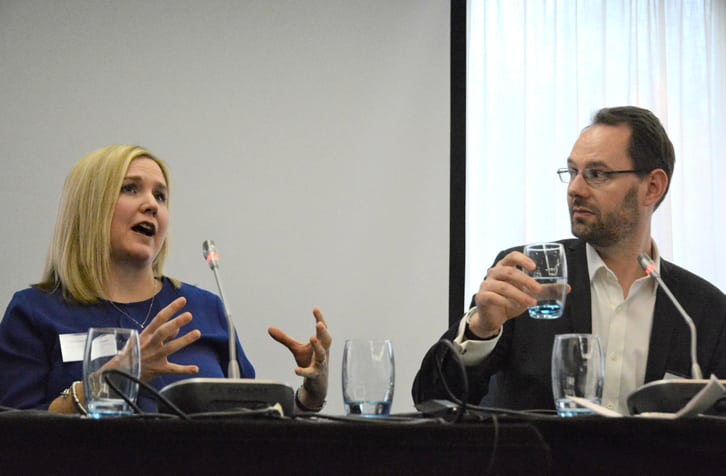
On a panel at the Opportunity 2018 Revenue Management 3:0 conference, InterContinental Hotels Group’s Shauna Campbell (left) told Accor Hotels’ Russell Low that metrics are unlikely to gain traction in an industry focused on rooms revenue. (Photo: Terence Baker).
Revenue per available room remains the principal focus for hotel companies gauging performance despite the value of examining a larger set of metrics, said panelists at a recent revenue-management conference in London.
LONDON—Hoteliers might like the idea of being able to measure asset and market performance using a variety of metrics, but in the current European business environment, analysis is often far too narrow, according to sources.
During the Opportunity 2018 Revenue Management 3:0 conference held last week, sources discussed how the need to look at new ways to analyze and push performance is hampered by disparity in contract setup and business models, wide-ranging targets which are often in conflict and hoteliers working in silos to achieve these goals.
“The right conversations do not happen,” said Shauna Campbell, director of revenue management at InterContinental Hotels Group.
During a breakout panel titled “Total revenue management: Why is it still so challenging?,” Campbell said revenue per available room will remain the major metric revenue managers use as long as owner contracts are set up to be focused on rooms revenue.
“That is the structure that drives most of the industry, so there is far less room to move on F&B and other parts of the equation,” she said.
Marta Varela, director of revenue strategy at Barceló Hotels, agreed.
“(Total revenue per available room) is the big illusion of the industry. It has been on the table for years, and we are far from being where we need to be in regards to it,” she said. “Rooms is 70% of revenue. TRevPAR sounds like good talk, but the industry has to work from scratch on it. The data is there, although it is not as easy to get as it is for rooms.”
Panelists said that equation is not true for all markets.
“We are predominantly franchised now, so our partners do not provide F&B data,” Campbell said. “Only a small percentage of owned properties do that. In the Middle East, the story is different as F&B makes up 70% of revenue, so there is more focus on it, although still there is no standard measurement.
“You cannot compare (F&B) with a (competitive) set, so everyone walks away to rooms,” Campbell added. “There are also no brand standards to F&B, (whereas) there are for (property management systems).”
Molding models
Analyzing different performance measurements is a wonderful exercise but one that is mostly rhetorical at this point, panelists said.
“One question would be to ask what the long-term goal is,” said Russell Low, director of revenue for U.K. midscale and upscale hotels at AccorHotels. “Is your comp set the right one, and if not, then how relevant is RGI (revenue generated index)?”
Varela added, “For some years, I’ve been trying to combine RGI with guest satisfaction, because maybe we are leaving money on the table?”
She said there seems to be the impression that to produce meaningful data, the entire hotel industry must be behind it.
Campbell brought up two other metrics: net RevPAR—guestroom revenue divided by the total number of available rooms after deducting the costs of customer acquisition, including sales and marketing, commissions and the costs of loyalty—and gross operating profit per available room.
“In terms of how we compete with others, it is all about looking at net RevPAR,” Campbell said. “Everyone is beginning to look at this, as this is how we can gain an edge over the competition.
“And (GOPPAR) definitely is something people talk to us about, but it feels like it is too far below the (profit and loss) line for larger chains. … GOPPAR is more of a measure for management companies, not franchisees.”
Another major difference is how often metrics are produced.
“My companies are cost-driven, so GOPPAR is a (key performance indicator) but only monthly data,” Varela said.
Definition dilemmas
Niels Mekenkamp, director of hospitality, pre-sales, Europe, Middle East and Africa, at analytics company Infor, said a major problem is that there are simply too many definitions for TRevPAR.
“Essentially, it is about optimizing channel costs, but there is a lot more to it,” he said. “I laugh when I hear people say we have to practice (meetings and events) revenue management. There are no TRevPAR numbers going down to the bottom line.”
Hoteliers in silos often have no time to dwell on the finer points of optimization and metrics, panelists said.
The problem is that performance is looked at mostly on a short-term basis, with most everyone working to satisfy this month or year’s budget, panelists added.
“Spa, golf? Do we have those skill sets in revenue management?” Low said. “I would say we do not have the skills, the knowledge or the comfort levels needed.”
“We do not all segment in the same way, and I have seen some creative accounting from GMs on top of that,” Campbell said. “We train GMs on RGI and RevPAR compared with the comp set.”


